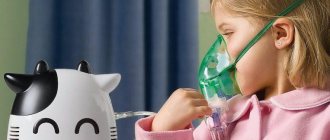Often a child feels sick without fever or diarrhea, what does this mean? The features of this symptom are of interest to parents who have encountered it. To eliminate vomiting, parents and doctors must know the reason for its occurrence.
Gastroenterologist Mikhail Vasilievich:
“It is known that for the treatment of the gastrointestinal tract (ulcers, gastritis, etc.) there are special drugs that are prescribed by doctors. But we will not talk about them, but about those medicines that you can use yourself and at home...” Read more >>>
Description of the disease
The child feels sick without fever and diarrhea occurs for the following reasons:
- gastrointestinal pathology (pylorospasm, pyloric stenosis, intussusception, gastroesophageal reflux disease, gastritis);
- regurgitation (they are observed in infants when overeating);
- endocrine disorders (adrenogenital syndrome, acetone crisis);
- diseases of the central nervous system (cerebral vomiting, brain tumor, increased intracranial pressure, migraines, brain injury);
- allergies to drugs.
If vomiting is caused by the medicine, stop using it. If the cause of vomiting cannot be determined independently, you should consult a doctor. He must make a diagnosis and select an appropriate course of therapy.
If, in addition to vomiting, the child has diarrhea, then he has food poisoning. If the intoxication (food poisoning) is minor, the only symptom will be vomiting.
Among the common reasons that can provoke diarrhea without fever in a child, we note:
- reaction to a stressful situation;
- overeating sweets;
- introduced complementary foods;
- unripe fruits, berries;
- eating low-quality foods;
- new bacteria entering the body.
Consequences of severe and repeated vomiting in a child
Despite the fact that vomiting in a child occurs without diarrhea or fever, it can cause serious consequences. Therefore, it is important to stabilize the baby’s condition.
No. 1. Aspiration pneumonia
The pathology develops against the background of penetration of vomit into the respiratory organs. The problem is that gastric juice poses a particular danger to lung tissue. In this case, a hospital is assigned. Mucus is suctioned from the trachea. If necessary, artificial ventilation is performed.
No. 2. Dehydration
If the body suddenly loses a large amount of fluid, the water-salt balance and the activity of all internal organs are disrupted. The child loses consciousness or has seizures. This condition is dangerous, especially for infants.
No. 3. Weight loss
When a child has nausea and vomiting, the body faces severe exhaustion. Even if the problem occurs without fever or diarrhea, serious consequences can develop. Within a day, a critical loss of body weight occurs.
No. 4. Bleeding
With intense vomiting, the mucous membranes of the entire gastrointestinal tract are injured. Against this background, capillaries burst. There is often blood in the vomit.
No. 5. Suffocation
With intense vomiting, the respiratory system may be damaged. Because of this, suffocation begins. This condition is dangerous for unconscious infants and children.
Important!
Even if a child’s vomiting occurs without diarrhea or fever, it is not recommended to resort to self-treatment. If the above symptoms occur, the help of a doctor is urgently needed.
Main symptoms
- Food poisoning, indigestion is accompanied by vomiting and diarrhea. There is no temperature. If the intoxication is minor, only vomiting appears. The same symptoms occur when overeating, indigestion, or taking medication.
- Metabolic disease. Often this pathology is represented by diabetes mellitus. This disease manifests itself in a child as an individual intolerance to cow's milk (whole milk), fruits, and cereals.
- Intestinal obstruction, intussusception. The pathology is observed in newborns and babies up to one year old. It occurs when it is impossible to contract and push feces to the rectum with a certain part of the intestine. In addition to vomiting, the baby experiences weakness, abdominal pain (acute, cramping), stools are like jelly (raspberry), in which there are streaks of blood, mucus, and pallor of the dermis.
- Neurological disorders, congenital pathologies. “Cerebral vomiting” indicates neurological abnormalities that occur during fetal development. They also occur due to asphyxia and birth trauma. With congenital cerebral pathology, the child experiences vomiting (profuse) and leakage of food from the esophagus. Vomiting is observed with brain tumors, traumatic brain injuries, and concussions. In addition, nausea, headaches, dizziness, and migraines occur. Vomiting also occurs with encephalitis, meningitis, and epilepsy.
- Pyloric stenosis. Retention of food inside the stomach, its pushing out occurs due to congenital narrowing of the passage between the stomach and duodenum. After eating, the child begins vomiting (fountain). In addition to vomiting, weight loss is observed.
- Acute appendicitis. Pathology practically does not occur in infants. It occurs already at school age. It is characterized by acute pain (in the navel area), lack of appetite, frequent bowel movements, urinary tract, and repeated vomiting. In some cases, diarrhea appears and the temperature rises.
- Foreign body inside the esophagus. In addition to vomiting, young children have: pain when swallowing, refusal to eat, anxiety, difficulty breathing, crying. Vomiting may occur repeatedly and does not bring relief.
- Cardiospasm. If the motor function of the esophagus is impaired, its expansion is observed after food enters it. Due to the inability of food to move further, vomiting begins, which is accompanied by coughing and pain in the chest. With this pathology, children do not get enough food and do not gain weight. Children with this disease are sometimes developmentally delayed.
- Inflammation of the digestive organs (gastroduodenitis, stomach ulcers, cholecystitis, colitis, gastritis, pancreatitis). Vomiting may be accompanied by diarrhea, but without fever. The vomit contains bile and mucus.
- Pylorospasm. With spasms of the pylorus, vomiting appears, it is not abundant and infrequent.
- Acetone crisis. It is characterized by the following symptoms: headache, smell of acetone from the mouth, weakness, nausea. The disease is often recorded in children whose age ranges from 2 to 10 years. Vomiting with this pathology is repeated, sudden, and profuse.
- Introduction of complementary foods. When new complementary foods are introduced, infants and one-year-olds experience vomiting as a one-time reaction to the new food.
- Neurotic vomiting. This pathology has been recorded in children over 3 years of age. Among doctors, it is known as psychogenic, functional vomiting. In addition to vomiting, the baby experiences overexcitation, fear, and anxiety.
What parents should do if their child is vomiting
If a child vomits without diarrhea or fever, the following actions should be taken:
- rinsing the mouth - after vomiting attacks, it is important to rinse the oral cavity; older children can carry out the procedure on their own;
- control the situation - babies are held in their arms, slightly bent forward, so that vomit does not penetrate the respiratory organs;
- correct position - the baby should be laid on his side, this will help prevent choking on vomit;
- Soldering - if the child is not feeling well, they are given rehydration solutions, drinking them in small doses every 5-7 minutes;
- Medicines - it is forbidden to give your child medications that relieve diarrhea.
There can be many reasons for vomiting in children. If there is confidence that such a condition is caused by intoxication, then it is allowed to give Smecta. Enterosorbent will relieve unpleasant symptoms when a child is vomiting. In other cases, you must wait for the doctor to arrive and not give other medications.
Diagnostics
For successful treatment of vomiting, which is not accompanied by fever or diarrhea, diagnostics are carried out. When examining a baby with excessive vomiting, use:
- Visual assessment. The doctor examines the vomit for the presence of certain impurities (blood, bile, pus, mucus).
- Evaluates the smell, consistency, color of the mass. This will help determine the disease that caused it.
- Laboratory research. They are needed to confirm/refute the alleged diagnosis.
- Instrumental examination of the gastrointestinal tract (X-ray, gastrofibroscopy, ultrasound).
Diagnosis and treatment of vomiting in a child
Effective treatment of vomiting can be carried out only if the symptoms are correctly identified. Unfortunately, this is not so easy to do. Vomiting is often a sign of a variety of diseases.
Diagnostics
In this condition, the following is done:
- research in the laboratory - vomit is sent to the laboratory, after which this or that diagnosis is confirmed/refuted;
- examination - the amount of impurities in the vomit is taken into account, as well as the consistency, smell, color, such parameters allow the doctor to determine the nature of the disease;
- examination - an additional examination of the digestive organs is carried out using special instruments, X-rays, gastrofibroscopy, and ultrasound are prescribed.
Treatment
If the causes of vomiting in a child, occurring without diarrhea and fever, have already been established, a highly specialized doctor prescribes a treatment regimen:
- the pediatrician is the first doctor who needs to be visited if there is frequent vomiting; he will refer you for examination to other specialists;
- surgeon - evaluates all variations, against which vomiting occurs, the reasons may be due to appendicitis, intestinal obstruction, cardiospasm, etc.;
- gastroenterologist - prescribes drug therapy and a strict diet for gastrointestinal pathologies.
In case of intense vomiting, you cannot do without an ambulance. If you don't react in time, the consequences can be dire.
What could vomiting and high fever indicate in a child?
Vomiting in children is often accompanied by other negative symptoms, such as high fever, diarrhea, abdominal pain and others. Let's consider the conditions in which the body's protective reaction in question occurs in conjunction with temperature:
- Intestinal infections. These include enterovirus infection, rotavirus infection, dysentery, salmonellosis, cholera and others.
- Intoxication of the body. Poisoning can occur as a result of consuming poor-quality food, chemicals, poisons, or medications.
- Infectious and colds. Vomiting in children often occurs due to influenza, chickenpox, scarlet fever, meningitis and other pathologies.
- Diseases of the digestive system. Among them, the most common in children are gastritis, colitis, appendicitis, gastroenteritis, and duodenitis.
From this list it is clear that the diseases described earlier in the article can occur both with and without fever. Be that as it may, if a child vomits, it is necessary to go to the hospital. The only exceptions are single attacks that do not disturb the general well-being of the baby. Take care of your children and be healthy.
All information in the article is provided for informational purposes only and is not a guide to action. Remember, self-medication can be extremely dangerous for your child's life.
Prevention
Today there are no special recommendations to prevent vomiting in a child without fever; however, the following general rules must be followed, which parents should monitor:
- ensuring the correct daily routine;
- rational and balanced nutrition;
- limitation from stress and emotional overstrain;
- eating only high-quality foods;
- avoiding contact with allergens;
- use of medications strictly as prescribed by the attending physician;
- regular exposure to fresh air;
- undergoing a full medical examination.
In the vast majority of cases, a symptom such as vomiting in a child without fever is favorable. The likelihood of complications developing is minimal, especially if parents are attentive to their child and have taken all measures for early detection and treatment of the disease or condition that could cause such symptoms.
The post-vomiting state of a child needs plenty of fluids and good nutrition. Especially if a girl or boy is found to be dehydrated. The amount of water needed to drink depends on the age of the child.
You should eat porridge with water, lean meat, and choose dairy products with less fat content. Reduce portions, increase the number of times you eat. Sweets and fatty foods should be excluded from the diet until complete recovery. Fruits, mainly citrus fruits, freshly squeezed juices are a necessity for complete recovery; the body requires vitamins and microelements.
Walking in the fresh air is necessary to improve your well-being. Many diseases occur due to oxygen starvation. Constant work with the psychological health of your child is required if the cause of vomiting was a traumatic event.
For diseases of the gastrointestinal tract and nervous system, you should follow your doctor’s recommendations. High-quality prevention will eliminate negative consequences and strengthen the baby’s immunity.
Treatment methods
Treatment of vomiting in a patient is carried out depending on the pathogenesis of the disease. To find out the true reason for the development of this protective reaction of the body, it is necessary to seek qualified medical help.
What to do for gallbladder diseases
Therapy for biliary dyskinesia is carried out using a diet, excluding from the diet foods containing large amounts of oxalic acid, as well as spicy, fatty, smoked, fried, pickled, and too salty foods. The baby’s diet must be saturated with fermented milk products, cereals, vegetables, fruits, and herbs.
Medicines:
- Holenzyme;
- Allohol;
- Flamin;
- Galstena.
Sedatives may also be prescribed, including Persen, Fitosed, Edas. In severe cases of the disease, physiotherapy methods have proven themselves well - electrophoresis, galvanization and others.
Infectious cholecystitis is treated with antibacterial drugs. The fight against parasitic infections is carried out with the use of Mebendazole, Pyrantel, Levamisole and others.
Treatment of pancreatic pathologies
Acute pancreatitis must be treated in an inpatient setting. In this case, bed rest and refusal to eat for 12 hours are prescribed. To maintain the body, injections of glucose solution are given, alkaline mineral water is allowed.
Drug therapy includes painkillers, enzymes, and antispasmodics. Metoclopramide is administered to stop vomiting. The dosage of the medicine is calculated by the doctor depending on the age and weight of the baby. After normalization of the child’s condition, a strict diet is indicated.
Treatment of acute appendicitis
In case of acute appendicitis, treatment is carried out exclusively in a hospital setting by surgery. The recovery period after surgery lasts 7-14 days. The patient is advised to diet and avoid physical activity.
Treatment of acetone crisis
Therapy for this condition is carried out exclusively in a hospital setting. The child is prescribed a strict diet with complete abstinence from fatty foods and plenty of fluid intake. In case of repeated vomiting, injections with antiemetics, antispasmodics and sedatives are given.
Children with acetone syndrome must be registered with a medical institution and undergo regular examinations.
Treatment of diseases of the central nervous system
Therapy of central nervous system diseases is a complex task. A neurologist is involved in the treatment. Depending on the severity of the course and the factors that provoked the disease, therapy for the disease is carried out at home or in a hospital setting.
You may be interested in: Vomiting and temperature of 38 in a child without diarrhea
Typically, the patient is prescribed drugs whose action is aimed at stimulating cerebral circulation. Severe hydrocephalus and brain oncology can only be treated surgically.
What to do if psychogenic vomiting develops
Vomiting without fever and diarrhea, which occurs against the background of severe emotional shock, fear or fright, is treated by seeking help from a psychotherapist. A specialist helps to find out the causes of stress and suggests methods for correcting the situation.
When introducing complementary foods
What to do if vomiting occurs after your child takes a new product? In this situation, it is better to refrain from eating this food for now. Perhaps the baby’s body is not yet ready to digest it. You should try again in a few months. By this time the body will be ready.
Treatment of gastroesophageal reflux
If a newborn regurgitates frequently, this should not be attributed to age-related characteristics. The child should be shown to a pediatrician or gastroenterologist. At an early age, it is possible to get rid of gastroesophageal reflux by switching to thicker foods and reducing portions.
If there are more serious problems, treatment is carried out with the use of drugs that suppress the production of hydrochloric acid. The doctor also prescribes antacids and medications that suppress the production of gastric secretions. Normalization of gastrointestinal motility is carried out with the help of prokinetics.
What to do for gastritis
Acute and chronic gastritis often occurs with the appearance of vomiting after eating. Treatment of the disease is carried out at home or in a clinic by a gastroenterologist. In acute cases of the disease, the patient must refuse to eat for at least 12 hours. The liquid should be taken in small sips.
Medicines:
- No-Shpa;
- Papaverine;
- Maalox.
After the end of the acute period, meatless food is allowed. The menu includes vegetable broths, jelly, and well-cooked porridge. It is forbidden to eat fatty, fried, spicy, salty, smoked, and sweet foods. In the future, the child must be registered in the hospital.
With timely and competent treatment, the prognosis for the patient is often favorable. Following a diet allows you to lead a fulfilling lifestyle.
Pyloric spasm
Treatment of the pathology is carried out by prescribing the patient a special diet and alkaline drinking. Antispasmodics are used as medications. It is important to follow the dosage of food in accordance with the age of the baby. You cannot overfeed your child.
Physiotherapeutic treatment, such as electrophoresis and paraffin baths, has proven itself well in the treatment of pyloric spasm.
Therapy for gastroduodenitis
Acute gastroduodenitis in children is treated mainly by following proper nutrition. Food should be taken in small portions. The frequency of doses is 5-6 times a day. In acute cases of pathology, bed rest must be observed.
Medicines are prescribed to reduce stomach acidity. Drugs such as Almagel, Omeprazole, Ranitidine are used. If the inflammation is caused by the bacterium Helicobacter pylori, treatment is carried out using antibacterial drugs. Among them, Metronidazole and De-Nol are often prescribed. In case of chronic duodenitis, the patient is indicated for sanatorium treatment.
What to do if a foreign body enters the gastrointestinal tract
If such a situation arises, the parents' reaction should be immediate. If the baby swallows a small smooth object, wait-and-see tactics are allowed. Most likely, the item will come out naturally. If a foreign body provokes suffocation, severe vomiting, or blood in the vomit, such a child requires urgent surgical treatment.
Even if a small object is swallowed, consulting a doctor is necessary.
Treatment of food poisoning
Food poisoning is accompanied by vomiting, abdominal pain, diarrhea or no diarrhea. Sometimes there is no temperature, but the character of the stool is not disturbed. Regardless of the accompanying symptoms, therapy should be carried out urgently. Among the medications, sorbents are used (Smecta, Enterosgel, Activated carbon). Antispasmodics are used to relieve pain.
In case of repeated vomiting, a gentle diet is necessary with the exception of spicy, salty, fatty, sweet, and smoked foods. You need to drink enough fluids per day to prevent dehydration. To normalize the functioning of the digestive system, the doctor may prescribe enzymes (Pancreatin, Creon, Mezim). Bacterial poisoning is treated with antibacterial drugs.
Relieving a baby from vomiting using traditional medicine
- Dill decoction . Dill is an excellent anti-vomiting remedy, especially since a decoction of it can be given to children of all ages, even infants. So, to prepare such a decoction, take fresh or dried dill and pour boiling water over it. You can either infuse the mixture for an hour, or keep it in a water bath for 15 minutes. The patient is given a dose depending on age: infants - one spoon, children over 5 years old - 3 spoons, but older children can be given this decoction without restrictions.
- Green tea . Also an excellent remedy for the symptoms of vomiting and nausea. It is better to use loose tea rather than from a bag. To improve its taste, add honey or sugar.
- Quince. Bake the fruit in the oven or simply grate it. The child will feel much better.
- Mint. Take either fresh or dried mint and pour boiling water over it. Infuse the mint for about 2 hours, and then let the child drink this decoction. Infants should be given 1 spoon 4-5 times a day. Older children can drink mint tea.
- Soda-saline solution . For half a liter of water, take one spoon of salt and soda and 4 spoons of sugar. Add ingredients to warm water to dissolve. Use the resulting solution as an anti-vomiting medicine.
What to do?
It is extremely difficult to independently determine why nausea occurs. Therefore, with such a symptom, it is necessary to show the child to the doctor. If the little patient’s condition is not impaired, then the visit to the specialist can be postponed until the next day. But you need to closely monitor the baby. Unpleasant symptoms may worsen at night.
Danger signs
It is necessary to call an ambulance as quickly as possible if the following clinic is observed:
- as a result of uncontrollable vomiting, it is impossible to give the baby something to drink;
- painful symptoms were provoked by taking mushrooms or canned products;
- the baby suffered a head injury;
- additional signs appeared (liquefied stools, increased temperature, drowsiness, severe pain, convulsions, impaired consciousness).
First aid
While the medical team arrives, parents need to know what to do and how to help the baby in order to protect the child’s body from serious consequences.
Home treatment includes the following recommendations:
- Regardless of whether vomiting began at night or during the day, the child must be put to bed. At the same time, lay the baby on its side. The little patient's head is slightly raised. This will protect against vomit entering the respiratory system.
- If nausea with a violent “eruption” began during the feeding process, then the procedure should be interrupted. In this case, it is better for the baby to be in an upright position.
- After each attack, wash your mouth with water.
- It is necessary to monitor temperature indicators.
- Be sure to give your baby something to drink. Repeated attacks can lead to dehydration. This is especially dangerous for infants, since severe complications occur much faster at this age. Recommended 1-2 tbsp. l. Give the baby water every 5 minutes.
What not to do
If your baby has a stomach ache and vomiting repeatedly, you should absolutely not look for the causes of this phenomenon on your own, much less treat the baby on your own. Such events often lead to aggravation of the situation.
Strictly contraindicated:
- Rinse the baby's stomach, especially if the patient is unconscious.
- Give painkillers, antispasmodics, without a doctor’s recommendation, even if the baby complains at night that his tummy hurts. These medications will change the symptoms, and it will be difficult for the doctor to make a correct diagnosis.
- Use antiemetics. Such treatment can seriously change intestinal motility, which will also lead to a loss of time in making a diagnosis.
- Take antibiotics or antiviral medications. Without establishing the true reasons that caused vomiting, it is difficult to choose the right treatment. Antibiotics will be powerless in the fight against a viral infection. But at the same time, they can reduce immunity and provide the child with dysbacteriosis.
- Giving your child drinks that can cause further dehydration. Tea, soda, juices, and milk can worsen the condition.
If an unpleasant attack happened at night, and in the morning the baby feels great, you should not refuse a visit to the doctor. This will make it possible to promptly identify any disturbances in the condition of a small patient and, therefore, begin treatment in a timely manner.
Symptoms
Vomiting without diarrhea and without fever may be accompanied by the following symptoms:
- Morning and general lethargy, impotence.
- Frequent salivation and involuntary swallowing.
- Strong heartbeat and shortness of breath.
- Prolonged nausea.
- Sweating.
- Pale skin.
Fever and diarrhea are absent when the baby regurgitates. It occurs both in a month-old baby and in one year, two years and up to three years. More often, regurgitation stops at 7 months.
- Repeated sudden, one-time fountain, no nausea.
- Pale facial skin.
- Tense, hard abdomen.
If the child feels well and has the listed symptoms, there is no need to worry. Regurgitation after eating is a natural phenomenon of the development of the digestive system. Signs of regurgitation independent of food consumption are dangerous: when the skin turns blue, the baby’s temperature drops, and repeated vomiting occurs.
The process of eruption through the mouth without diarrhea, temperature, depending on the influencing factor, is divided into types:
- Psychogenic vomiting, the cause of which is problems with the central nervous system in children. The psychogenic form is diagnosed in a teenager, a child of 6-7 years old, and rarely in a small child. This type includes kinetosis - the process of motion sickness in transport: land, water, which results in vomiting.
- The urge to vomit is caused by the presence of gastrointestinal diseases.
- Eruption of stomach contents without fever, caused by poisoning.









